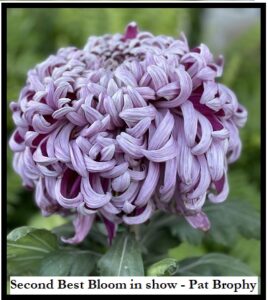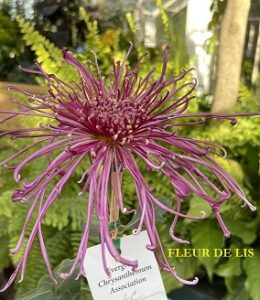To Do List -Jan. 2014
1. Clean up your cutting beds, Temp. controls etc- See Dec. 2013 newsletter for details.
2. Continue the white Rust program -From November letter i.e. spraying stools 3 times with
Eagle or Immunox fungicides. You should be finishing up this month.
3. Lay out your growing plans for the year ( Cultivator list). I like to break it down into 3 or 4 sections i.e.
-Large & Mediums (1s&2s)
-Incurves
– Late Decoratives and Fantasies and
– Early English & Garden varieties.
When you group them together like this you will find the start dates and stop dates to be much more cohesive as many in a group tend to work alike.
4. Now go to work and plan your stopping dates and then back to your cutting dates.
5. Start taking cuttings per your plan. Note, Most of the mums needn’t be Started in January, but a few really need an early start.
6. Refer to previous meeting notices for detail on how to take cuttings and care for them.
Cultural notes:
We’re now at a crossroads in two areas: 1. Starting media & 2. Starting times/Pinch dates.
-Past practice has relied primarily on starting in cutting beds, or sometimes starting directly in 2 1/2 ” cross bottom squares or variations thereof. In most cases a cutting bed with a starting media and temperature controlled heating elements such (heat pads, heat coils, other) plus overhead protection (clear Plastic or glass) and overhead light was a standard approach.
-In 2013, Chris Brookes picked up on the cutting method currently used by Ray Gray of Kings Mums which uses “Earth Pots”. These come in trays of 72 starting modules. A cutting bed per se is not required, but you still need to provide a source of even temperature controlled heat , overhead protection, overhead lighting plus overhead spraying.
OK so there are differences. That doesn’t mean one approach is right and the other is wrong.
Let’s do some comparisons:
Consideration Earth pots: Cutting Bed
– Number of starts per flat 72 60-72
-Time to transplant 24-28 Days 24-28 days
-Root system at transplant looks good Superb- Maximum # roots per stem
-Transplant to… 3″ pot 2 1/2″ pot
-Time to next potting 4 weeks 3+ weeks
-Costs similar similar -Convenience Requires continual spraying water every 3-4 days
-Soil borne disease None -some, That’s why we change
carry over the medium every few years
-Cutting Yield 95% 90-95%
There’s not much difference in the comparisons so at this stage we’ll just have to wait and see !
Now let’s look at the other Quandary– Starting times and pinch dates. These are very closely intertwined and are dominant factors affecting the date when the blooms will be fully out.
However the individual cultivar characteristics and local weather also play a major role in the final bloom time. Lastly, the finishing areas and late temperature controls available can have a significant effect on when the blooms would achieve their maximum potential. I used to have a green house and a closed in shed in which to finish the blooms. I could control the finishing environment quite closely. I now have moved and am finishing outside in open lexan covered areas where I can’t control the weather or the temperature. In this new environment, I can still successfully produce quality mums, but I can’t rush them along like I used to. So let’s not kid ourselves, growing show quality mums to their maximum potential is an Art, not a Science.
Now if you are at a loss on start dates and pinch dates, join the crowd; then work to develop dates that work for you in your environment. Keep in mind we are endeavoring to develop exceptional show quality blooms. Here’s a few thoughts that may help you sort some of it out.
1. We use the Japanese developed method of gradually moving the plants to increasingly larger pots throughout the growing season. This technique is employed to develop a much stronger root system. I continue to work on any advantage I can find to develop a much stronger root system and in time to support the planned Full blossom date. To this end I’ve changed my cutting bed medium . I now use a medium of approximately 50% Green Mountain sharp white sand and 50% Pro-Earth #2 starting mix. My results the past 2 years have been great rooted cuttings into the 2 1/2″ pots with many roots progressing upwards along the stem for nearly an inch. The White sharp sand is responsible for all the roots as the sharp sand edges penetrate the cambian layer resulting in new roots where the layer was broken. The Pro-earth #2 potting mix has a moderate amount of slow release fertilizer. Combined I’m getting strong lush cuttings, rooted and ready to transplant in 21-25 days. The Earth -Pots approach discussed earlier has potential for similar results, but the ability to produce the really strong rooted cuttings has yet to be established. I’m betting that they will prove out very well..
2. To some extent, we as a club have been starting many varieties earlier than necessary. Many of us have started early and run into the April blahs where the plants may stall out and we barely get the plants into the 9″ pots by June first. Why does it matter? Regardless of your pinch date, the plants will rarely throw a bud until it has started to get root bound. So if you need buds by the first week in August you can’t have your 9″ pot on occurring the end of June.
Most of the above relates to the exhibition class mums-sections 1 thru 10. Early English classes. sections 13 through 25 are a different story entirely as they have been cultivated and developed mainly for growing in the open garden and they tend to bud more quickly and flower earlier than the other varieties. Also, their budding dates are not usually affected by the need for the roots to become root bound. Most garden varieties fall into this category also.
All that having been said, It’s still necessary to start many of the big blooms early, but not in early Jan. as Stark has been accustomed to do.. If we wait until late Jan. or Feb to take the cuttings, we will generally have healthier cuttings that come along faster, but are still in manageable pot sizes when the April blahs arrive. So maybe we can keep them in dry covered and maybe slightly heated areas into May; thus avoiding the April stalls. Chris Brookes is pushing hard to move our start dates out and to some extent the pinch dates also.
I concur with those ideas to some extent, but let’s be cautious. Many of the #1s 2s & 3s still need an early start – maybe not all in January .but there are lots of others that can wait till Late
Feb. or mid March.
Another consideration is our plant sale usually held on the second Saturday of April. If you delay your starts past mid March you won’t be able to get them into the plant sale.
drs 1/2/2014




